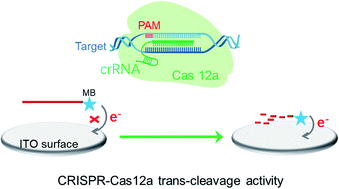An ultrasensitive homogeneous electrochemical biosensor based on CRISPR-Cas12a
Abstract
Taking advantage of the high-efficiency indiscriminate ssDNA cleavage activity of Cas12a in combination with the diffusivity difference of methylene blue (MB)-labeled probes (short oligonucleotides/mononucleotides) toward the negatively-charged indium tin oxide (ITO) electrode, a simple, immobilization-free, highly sensitive, and homogeneous electrochemical biosensor for the detection of human papillomavirus (HPV-16) has been fabricated. At the core of the detection process, Cas12a employed ssDNA trans-cleavage capability to achieve short-strand nucleotide cleavage, while MB-labeled probes served as high-efficiency homogeneous electrochemical emitters to achieve differential pulse voltammetric (DPV) signal. Specifically, due to strong electrostatic repulsion, MB-labeled short oligonucleotides (reporter) cannot diffuse freely to the surface of the negatively charged ITO electrode, and only weak electrochemical signals can be detected. The presence of the target HPV-16 can activate the Cas12a complex to perform indiscriminate ssDNA cleavage of the reporter to produce MB-labeled mononucleotides. The MB-labeled mononucleotides with a smaller size have almost no negative charge, so they very easily diffuse to the surface of the ITO electrode and result in an enhanced electrochemical signal response. Different electrochemical responses (DPV peak intensity) of the CRISPR-Cas12a-assisted amplification strategy can be obtained through the diffusion rate of different MB-labeled DNA on the electrode, which is also positively correlated with the input HPV-16 concentration. Given the unique combination of the CRISPR-Cas12a system with the homogeneous electrochemical solution phase, the detection limit is determined to be 3.22 pM (wide dynamic working range from 0.01 nM to 100 nM) and the two-step detection workflow could be completed within 50 min at ambient temperature, which is superior to that of the HPV-based biosensors previously reported.

- This article is part of the themed collection: Analytical Methods HOT Articles 2021


 Please wait while we load your content...
Please wait while we load your content...